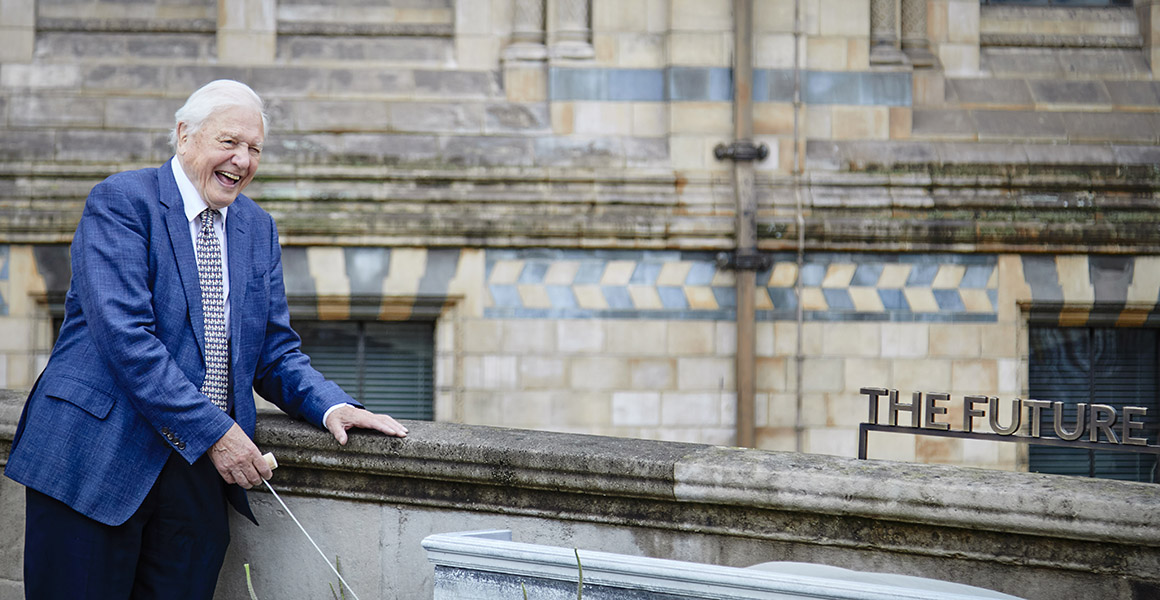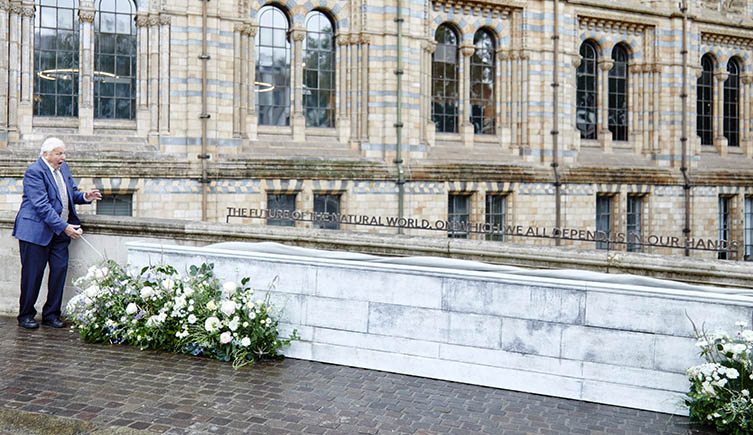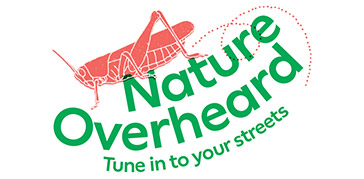The renowned broadcaster Sir David Attenborough has unveiled a quote of his outside the Natural History Museum.
The quote will form part of the newly developed gardens at the Museum as part of the broader Urban Nature Project.

Attenborough visited the Museum this morning to unveil his quote in front of the Museum. ©The Trustees of the Natural History Museum, London
The renowned broadcaster Sir David Attenborough has unveiled a quote of his outside the Natural History Museum.
The quote will form part of the newly developed gardens at the Museum as part of the broader Urban Nature Project.
Sir David Attenborough visited the Museum today to unveil a quote of his that has been immortalised in the newly developed gardens.
Sir David Attenborough’s compelling words, ‘The future of the natural world, on which we all depend, is in our hands’ were unveiled in bronze lettering outside the Museum’s main entrance and will overlook the new gardens.
At the unveiling of the quote, Attenborough said, ‘Each of us must cherish the natural world that surrounds us, from wide open countryside to tiny patches of green in our cities.’
‘I hope the Urban Nature Project and the new gardens at the Museum will take learning into the open air and inspire young people to continue to value, understand and support the natural world on their doorsteps and far beyond.’
The new quote forms part of the Urban Nature Project, which is overseeing the redevelopment of the Museum’s five-acre grounds which will open in spring 2024.

Attenborough unveiled his quote outside the natural History Museum with the Director Doug Gurr ©The Trustees of the Natural History Museum, London
‘We were honoured to welcome Sir David Attenborough to the Museum this morning to unveil his powerful and inspiring words which will overlook our new gardens,’ says Dr Doug Gurr, Director of the Natural History Museum.
‘Knowing that the UK is one of the most nature-depleted countries in the world, it’s more important than ever to protect the wildlife in our urban spaces. Through the Urban Nature Project, the Museum is encouraging visitors and young people to explore natural history in a new way, giving them the tools to look to the future and safeguard nature in towns and cities.’
The grounds of the Museum are currently undergoing their biggest redevelopment since the building was first opened to the public 142 years ago.
The eastern side of the gardens will take visitors on a journey through time as they trace the evolution of plants over 540 million years from the smallest moss to the biggest tree fern, coming face to face with the occasional dinosaur or trilobite along the way.

The quote will greet visitors as the enter the Museum through the main doors ©The Trustees of the Natural History Museum, London
The opposite side of the gardens will be a haven for urban wildlife, as the Museum’s established wildlife garden is improved and expanded. The enlarged pond will allow more space for children to pond dip, the improved meadow will be buzzing with insect life, while the dedicated classroom will provide an ideal setting for school kids to learn about the nature and biodiversity that surrounds them in towns and cities.
In addition to all of that, the Museum is setting up monitoring devices around the gardens to record, track and study all the life that makes the grounds home. This will include listening in to the birds and bees, sampling the insects and testing the quality of the air so that scientists can better understand the intricacies of urban biodiversity.
You can find out more about the Urban Nature Project and how to support it.

Want to dive further into urban nature? Join our scientists by taking part in Nature Overheard.
Don't miss a thing
Receive email updates about our news, science, exhibitions, events, products, services and fundraising activities. We may occasionally include third-party content from our corporate partners and other museums. We will not share your personal details with these third parties. You must be over the age of 13. Privacy notice.
Follow us on social media